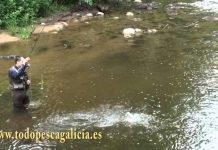The ballast in spearfishing
The ballast in spearfishing is a very important component. Often known as the weight, sometimes it is just a belt with weight. But it should go further. The ballast is very important, in the fishing technique, in safety and in efficiency. Let’s see it a bit more in depth.
The first thing we have to keep in mind is what is the appropriate ballast. And there is not only one answer, we have to analyze what type of fishing we are going to practice. Depth, wetsuit and personal taste intervene in this decision.
To start, a multi-purpose ballast has to be that one that in the surface, without kicking, makes us float with the water level around our nose, a little bit below it. If we float more we will be under-weighted, and if we sink more we will be over-weighted. The ballast depends on factors like the wetsuit (thickness and type of neoprene) and also the constitution of each person. With the same wetsuit and the same weight two people don’t have to use the same ballast. A personal test has to be done. In a lot of cases it can be a 3 or 4 kilos difference. This is due to body fat, lung capacity, constitution…
– POSITIVE BUOYANCY: We float. At a given depth, the ballast doesn’t compensate the buoyancy of our wetsuit and we ascend.
– NEUTRAL BUOYANCY: The ideal. We don’t float or sink. We have to look for this for the depth we are spearfishing at.
– NEGATIVE BUOYANCY: We sink. The ballast we have is too much for the depth we are.

Especially when we are starting, is better to go under-weighted for safety reasons. It’s much more comfortable and safe to ascend fast for not having enough weight, than having too much after a dive and have trouble to ascent. Especially when we don’t have experience, and the stress factor can make the ascent even more difficult. When we gain more experience, we adjust the ballast better.
In some very specific spearfishing techniques, like under the breaks in very shallow depth, it’s possible to go over-weighted, to be able to handle the waves’ movement and stay close to the bottom. But just when the dives are very shallow, and you are already an experienced spearfisher.
In spearfishing and freediving it will always be used a flexible belt. This helps to adjust it to the body, and prevents undesirable movements and the possibility of falling, even to the feet or even to the chest, when we are vertical. It can be marseillaise style or with an adjustable buckle. But always made of elastic rubber. It’s also very important the position we wear it. It’s habitual, among beginners, to wear it in the waist, tight. This will cause difficulties when breathing, and it will make difficult a proper belly breathing. Breathing will be addressed in a more in detail article. So, the belt must be placed in the hips, tight to avoid undesirable movements. And better with a strip we can put between our legs to avoid it moving to our waist when we descent in vertical position. We will see a substantial improvement in our breath-holds.
We also have the option of distributing the ballast between the belt and a vest or baudrier. Specially when we need a lot of weight, it will help to avoid lumbar contractions and other back problems after long sessions. And also for the ones who already have this kind of problems. A vest with 4 kilos will make a lighter belt. Although we will have to take in mind that our body position will change, lowering more our upper body (shoulders and head). It helps during the waiting technique and it keeps us more horizontal on the bottom. But on the surface it also keeps our head lower, and during the first days it is possible to get this area more tightened.
It is also possible to use ankle weights, but I only recommend it for waiting spearfishing with little swimming, because the extra weight will make our legs more tired.
To get started or when we change the wetsuit, we will always go to the water with less weight, and we will be increasing it until being comfortable. We can do this carrying a couple of weight pieces on the buoy. As the wetsuit gets older, its buoyancy will be less.
When we spearfish deep, we must to use less weight. So we are neutral on the bottom, and the ascent it’s safe and comfortable. It’s better to do more effort when descending than start ascending and feel we can not do it or we need a huge effort. For this purpose it’s also possible to use a sputnik or variable weight (for example a buoy weight, and leave it on the bottom). The sputnik will be addressed in the future.
The idea we need to understand is that the ballast has to be the right weight, and if not, always go under-weighted, because we have to be able to ascend. And under any difficult situation, don’t hesitate and RELEASE the ballast. For this purpose, the belts must have a quick release system, and if we use a strip between our legs, it should be released at the same time as the belt. Without the weights we will ascent fast and without effort. It’s better to lose a belt than remain on the bottom or suffer a blackout.
































